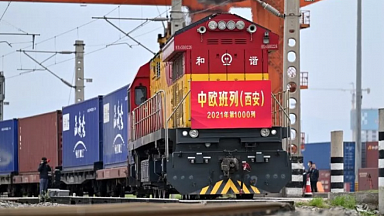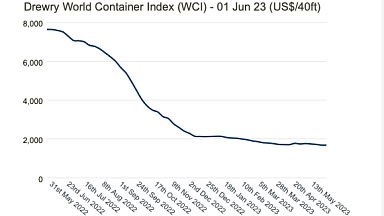In recent weeks, sea freight rates have risen noticeably, sparking fears among shippers that the sky-high prices seen during the pandemic could make a comeback. Amid the ongoing disruption sparked by the Red Sea crisis, Xeneta Chief Analyst Peter Sand has suggested that shippers should remain calm, and stressed that a repeat pandemic-type situation is not likely. However, Sand also did not go so far as to rule out this scenario entirely.
Freight rates continue to climb
Recent days have seen freight rates continue on an upward trajectory. According to the latest weekly FreightOS Baltic Index (FBX) release on Thursday July 4th, the global container freight index was at $5,023, marking an 11% increase compared to the previous week.
The FreightOS data also shows that specific routes are seeing even more pronounced changes, such as the China/East Asia to North America West Coast line, which has gone up 12% to $7,930. Similarly, the China/East Asia to North America East Coast route rose 8% to $8,897.
Adding to this, Drewry’s World Container Index (WCI) has also reported a significant increase. The composite index increased by 10% to $5,868 per 40ft container this week and has surged by 298% compared to the same week last year.
Notably, rates from Shanghai to New York rose by 17% to $9,158 per 40ft container, and rates from Shanghai to Los Angeles increased by 12% to $7,472 per 40ft container. Similarly, rates from Shanghai to Rotterdam went up by 10% to $8,056 per 40ft container.
What’s causing the upturn?
According to Xeneta Chief Analyst Peter Sand, several factors are contributing to the market conditions we see today.
Firstly, the continued economic recovery post-pandemic has led to increased demand for goods, exacerbating the pressure on shipping capacities and driving up freight rates. In addition to this, the other well-known factor is the conflict in the Red Sea region and the need to reroute around the Cape of Good Hope.
In a recent analysis piece, Peter Sand highlights that routes from the Far East to the US East Coast and West Coast have seen rates surge by 268% and 366% respectively since December 2023.
Sand notes that although pandemic spot market rates are unlikely to materialise, such a scenario cannot be ruled out completely:
«At this point, it is not likely we will see the spot market reach the heights of the Covid-19 pandemic, but it cannot be ruled out completely and the response of both shippers and carriers in the coming months could be decisive,» says Xeneta’s chief analyst.
Furthermore, Sand adds that major transshipment hubs like Singapore and Port Klang in Malaysia are experiencing high levels of congestion. This congestion, he says, results from increased volumes and strategic decisions by carriers to reduce port calls, leading to bottlenecks.
«With the average TEU of each ship arriving in Singapore rising by 18.5% from January to May, it is not surprising to see congestion has now reached its second-highest level ever, and just 1.9% shy of the August 2021 record of 2,997 TEU per container ship arrival,» writes Sand.
What lies ahead
Looking ahead, Sand states the future trajectory of sea freight rates will depend on several factors.
First and foremost, the response of shippers and carriers will be crucial. According to Sand, if shippers continue to frontload imports in anticipation of further rate hikes, and carriers do not address congestion issues by diversifying their port calls, rates could continue to rise.
«Shippers can play a part in helping to ease the pain points in global supply chains by remaining calm and collected,» says Sand. «We do not yet know how high spot rates will climb — and we can expect an impact on the long term market. If shippers do want to wrestle back some control over the situation, then they should keep as many options open as possible.»
However, Sand states there are already signs that carriers are beginning to adjust their operations to alleviate some of the congestion. For instance, MSC’s ‘Britannia’ service has altered its route to bypass Singapore, potentially easing some congestion in the region.
When it comes to other influential factors, Sand believes that economic and policy changes such as global trade policies, such as new tariffs or trade agreements will also play a significant role. Additionally, Sand concludes that potential strike actions at major ports or new tariffs under different political administrations could lead to further market disruptions.




